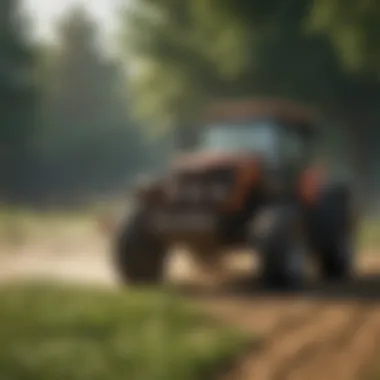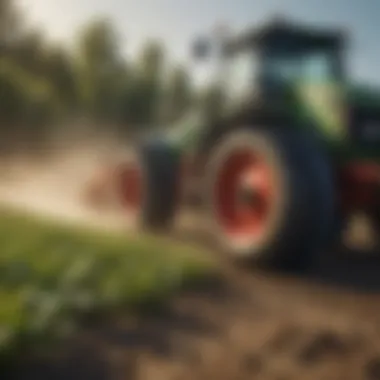Understanding Key Components in Weed Killers


Intro
Understanding the main components in weed killers is crucial for those who seek efficient solutions in agriculture and gardening. With numerous products on the market, clarity about the chemicals and their impacts is essential. This segment will set the stage for deeper discussions about specific ingredients, their chemistry, and implications for safe and effective use.
Key Concepts and Terminology
Basic Definitions
Weed killers, commonly known as herbicides, are substances designed to eliminate unwanted plants. They work by targeting specific biological processes within those plants. Understanding basic terms helps in grasping how these substances function and their role in weed management.
- Herbicide: A chemical that destroys or inhibits the growth of plants.
- Selective Herbicide: Targets specific plant types while sparing others.
- Non-Selective Herbicide: Affects all plant life, making it more potent and risky in non-target areas.
Historical Context
The development of weed killers dates back to early agricultural practices. Originally, farmers relied on simple methods like hand-pulling or using fire. In the mid-20th century, the advent of synthetic chemicals revolutionized weed control, making it more efficient. However, this increased reliance on chemicals has also raised concerns over safety and environmental impact.
Recent Innovations and Trends
Technological Advancements
New formulations and application techniques have emerged in recent years. Innovations in chemical engineering have led to herbicides with increased efficacy and reduced toxicity. Moreover, precision agriculture tools provide enhanced capabilities to apply these substances more accurately, reducing waste and potential harm.
Sustainable Practices
The shift towards organic and eco-friendlier alternatives has gained momentum. Many farmers now consider integrated pest management, using natural herbicides derived from plants, which serve as both effective and safer choices for the environment.
Practical Applications and Techniques
Step-by-step Guides
Understanding how to use weed killers effectively is paramount. Follow these general steps:
- Identify the Weed: Knowing what you're dealing with can influence your choice of herbicide.
- Choose the Right Product: Based on whether the weed is broadleaf or grassy.
- Follow Label Instructions: This ensures proper dilution and application rates.
- Apply at the Right Time: Weather and growth stage can affect effectiveness.
- Monitor the Area: Check for signs of efficacy or potential damage to desired plants.
Case Studies
Several farmers have successfully implemented new methods for weed control. For instance, a case study in the Midwest highlighted a farmer's use of pre-emergent herbicides alongside crop rotation. By adopting this strategy, he managed to control weed populations with less reliance on post-emergent applications.
"Understanding the right product and timing can drastically improve your results in weed management."
By exploring these facets, the article will provide insightful information for agriculture farmers and enthusiasts, equipping them with the knowledge necessary for effective weed management.
Preface to Weed Killers
Weed killers play a crucial role in modern agriculture and gardening. Managing unwanted plants, or weeds, is essential to ensure that crops have the resources they need to grow. These chemicals, commonly referred to as herbicides, are specifically designed to target and eliminate weeds while avoiding harm to desired plants. Understanding weed killers is not just about knowing what they do; it is about appreciating their place in sustainable agricultural practices and their environmental implications.
Definition of Weed Killers
Weed killers, also known as herbicides, are chemical substances used to control or eliminate unwanted vegetation. They work by attacking specific processes in the target plants that differ from those in crops. There are various formulations available that vary in their effectiveness, mode of action, and residual effects. Herbicides can be classified into two main categories: selective and non-selective.
Selective herbicides target specific types of plants, usually invading weeds, while leaving crops unharmed. Non-selective herbicides, on the other hand, kill all vegetation they contact. The use of these herbicides has transformed the way we approach weed management and crop production.
Importance in Agriculture
The significance of weed killers in agriculture cannot be overstated. They enhance crop yields, reduce the labor needed for manual weeding, and help maintain crop quality. Weeds compete with desired plants for nutrients, water, and light. This competition can drastically lower the productivity of farmers' crops.
Some key points on the importance of weed killers include:
- Increased Efficiency: Herbicides allow farmers to manage larger areas more effectively than by manual weeding.
- Cost-Effectiveness: The use of herbicides can lower production costs by reducing the time and resources needed for weed control.
- Sustainability: When used judiciously, herbicides can fit into an integrated pest management strategy that promotes sustainability on farms.


However, there are critical considerations that accompany the use of these chemicals. Over-reliance on herbicides can lead to resistance in weed populations, requiring ever-stronger chemicals or newer methods. Moreover, the impact of herbicides on non-target organisms and soil health must be considered to foster a balanced ecosystem. Thus, understanding weed killers involves recognizing not just their benefits, but also the challenges posed by their applications.
Main Ingredients in Weed Killers
Weed killers serve an essential function in modern agriculture and gardening practices. The main ingredients in these products determine their effectiveness, safety, and environmental impact. Understanding these ingredients is crucial for farmers and horticulturalists who aim to manage vegetation competently while minimizing adverse effects on their crops and the surrounding ecosystem. This section highlights the key ingredients found in weed killers, discussing their unique properties, applications, and the considerations that accompany their use.
Overview of Common Ingredients
Weed killers often contain various chemical compounds, each serving a specific purpose. Some of the most common ingredients include glyphosate, 2,4-Dichlorophenoxyacetic acid, aminopyralid, and pelargonic acid. Each of these has distinct capabilities in targeting unwanted plants. Here is a brief overview:
- Glyphosate: A widely used systemic herbicide that affects a broad spectrum of plants by inhibiting a specific enzyme pathway.
- 2,4-Dichlorophenoxyacetic Acid: A selective herbicide effective on broadleaf weeds in cereals and grasses.
- Aminopyralid: Targets specific tough weeds, offering solutions in pasture and forage management.
- Pelargonic Acid: An organic herbicide option that acts as a contact herbicide, suitable for home gardens and organic farming.
Each of these ingredients has its unique benefits, risks, and regulatory considerations, making the knowledge of them valuable for maximizing agricultural efficiency.
Glyphosate
Chemical Properties
Glyphosate is a systemic herbicide, meaning it is absorbed through the leaves and translocated to the roots. Its chemical structure allows it to effectively target and inhibit specific metabolic pathways in plants, particularly the shikimic acid pathway. This pathway is crucial for the synthesis of essential amino acids in many plant species.
One key characteristic of glyphosate is its broad-spectrum action. It can control many types of weeds, which makes it a popular choice for agricultural practices. However, its effectiveness varies depending on the species of weed and environmental conditions. A common disadvantage is its potential for developing resistant weed populations if used excessively or improperly.
Mechanism of Action
The mechanism by which glyphosate exerts its effect is through the inhibition of the EPSP synthase enzyme, disruptting amino acid production. As a result, target plants die because they cannot synthesize proteins essential for growth and survival. This specificity toward certain biochemical processes in plants is a notable benefit, allowing for effective weed management without instantly harming all plant life in the vicinity.
Nonetheless, it is essential to consider that the overuse of glyphosate can contribute to resistance, leading to the emergence of tougher weeds that require alternative management strategies.
Controversies and Regulations
The use of glyphosate has sparked considerable controversy due to concerns about its long-term health effects and potential link to certain cancers. Regulatory bodies, such as the U.S. Environmental Protection Agency, have evaluated its safety and established guidelines for application and usage. The key characteristic here is that, while it is highly effective, users must comply with safety regulations and application guidelines to minimize risk to human health and the environment. Moreover, public opinion and regulatory frameworks can significantly impact its availability and acceptance.
,4-Dichlorophenoxyacetic Acid (,4-D)
Function and Applications
2,4-D is a selective herbicide mainly targeting broadleaf weeds. It is commonly used in agricultural settings to protect crops like corn and wheat, where these weeds typically compete for nutrients and water. The unique function of 2,4-D lies in its ability to mimic natural growth hormones in plants, leading to uncontrolled growth and subsequent death of the targeted weeds.
Its selective action is a notable advantage since it allows farmers to control unwanted vegetation without damaging certain crops. However, this specificity means farmers need to apply it carefully to avoid affecting nearby sensitive plants.
Environmental Considerations
The environmental impact of 2,4-D is a significant consideration. It has the potential to affect non-target species if not applied properly. The chemical can leach into water sources, which poses risks to aquatic ecosystems. Thus, proper application guidelines are crucial to limit these risks. Farmers are encouraged to apply it during stable weather conditions and assess local wind patterns to prevent drifting onto non-target areas.
Aminopyralid
Target Weeds
Aminopyralid is especially effective against tough perennial weeds such as thistles and dandelions. This herbicide disrupts plant growth by interfering with hormonal processes and is often used in pastures, rangelands, and non-crop areas. Its ability to break down more slowly in the soil than some other herbicides is a benefit, allowing it to continue working on weeds over an extended period. However, this persistence can have implications for sensitive crops planted later in the season or the following year.
Usage Guidelines
When using aminopyralid, adhering to guidelines is vital to minimize unwanted effects. Recommendations usually include specific timing for application and advised intervals before planting sensitive crops. Ensuring these protocols can significantly reduce the risk of injury to crops and help maintain effective weed control throughout the growing season.
Pelargonic Acid
Organic Herbicide Options
Pelargonic acid is derived from natural sources and serves as an organic herbicide. It acts as a contact herbicide, meaning it needs direct application to the plant surface to be effective. It is often used in organic gardening and is friendly to beneficial insects. One of its benefits is that it decomposes quickly, posing less risk of residual herbicidal activity in the soil. This can make it appealing for gardeners who prioritize eco-friendly options.


Effectiveness and Limitations
While pelargonic acid provides a more natural approach, it is not as effective against deep-rooted perennial weeds as some synthetic options. Its primary limitation lies in its contact action, as it may require multiple applications for sustained control of larger or tougher weeds. Users should balance between using a more sustainable option and the levels of weed control they need for their specific environments.
Types of Weed Killers
Understanding different types of weed killers is crucial for anyone involved in agriculture or gardening. This knowledge helps in selecting the right product for specific weed challenges, ensuring effective management while maintaining crop health. Each type of herbicide serves unique purposes and functions, which can significantly impact farming practices. Misapplication or misunderstanding of these products may lead to crop damage, ineffective weed control, or environmental harm. Thus, exploring the types of weed killers provides deeper insights into their usage, efficacy, and safety measures.
Selective vs. Non-Selective Herbicides
Selective herbicides target specific weeds without affecting the surrounding crops. This makes them invaluable for maintaining effective weed control in established gardens and agricultural settings. For example, Glyphosate is a widely used non-selective herbicide, often employed in situations where complete vegetation clearance is necessary. It kills any plant it comes in contact with, which can be effective but risky if misapplied.
On the other hand, 2,4-Dichlorophenoxyacetic Acid (2,4-D) is a selective herbicide that primarily affects broadleaf weeds while sparing most grasses. Understanding these distinctions helps farmers make informed decisions based on the type of crops they grow and the weeds they face.
Key Differences:
- Selective Herbicides:
- Non-Selective Herbicides:
- Target specific weed species.
- Preserve desired plants during application.
- Examples: 2,4-D
- Affect all plants in the area.
- Use is effective for total weed control.
- Example: Glyphosate
Post-Emergence vs. Pre-Emergence
Timing is a critical factor in weed management. This is where the distinction between post-emergence and pre-emergence herbicides comes into play.
Pre-emergence herbicides are applied before weeds germinate. They create a chemical barrier in the soil, preventing seeds from sprouting. Products like Aminopyralid fall into this category and are particularly useful for managing annual weeds.
Post-emergence herbicides are used after weeds have emerged from the ground. They are designed to target already growing weeds, effectively controlling them before they can compete with crops. This type includes the aforementioned Glyphosate, which kills actively growing plants.
Application Considerations:
- Pre-Emergence:
- Post-Emergence:
- Prevents weed growth before it starts.
- Requires proper timing for effectiveness.
- Example: Aminopyralid
- Target existing weeds for control.
- Can be more flexible but must account for weed sizes and types.
- Example: Glyphosate
Understanding these differences in weed killer types can empower farmers and gardeners to make choices that best suit their specific needs, minimizing unwanted side effects while achieving effective weed control.
Safety Measures and Best Practices
Using weed killers involves risks that can potentially harm the environment, people, and non-target organisms. Thus, implementing safety measures is critical for ensuring the well-being of users and maintaining ecological balance. This section delves into necessary precautions and best practices when working with these substances.
Personal Protective Equipment
Personal Protective Equipment (PPE) is essential when applying weed killers. The goal is to create a barrier between the chemicals and the skin or respiratory system. Here are some important components of PPE:
- Gloves: Wear chemical-resistant gloves to protect the hands from direct contact with harmfull substances.
- Face Masks or Respirators: These are necessary to prevent inhalation of harmful vapors or aerosols during application.
- Goggles: Eye protection is crucial as splashes can cause irritation or damage.
- Protective Clothing: Long-sleeved shirts and pants, along with boots, can provide an extra layer of protection against spills or splashes.
The use of proper PPE not only protects the user but also minimizes the risk of accidental exposure to bystanders. Regular checks of equipment can ensure effectiveness. Users should also adhere to the manufacturer's recommendations regarding PPE use for specific products.
Application Techniques
The method of applying weed killers significantly influences their efficacy and safety. Proper application techniques minimize the risks to both the applicator and the environment. Here are essential techniques to consider:
- Targeted Application: Aim to apply weed killers directly onto the target plants instead of broad spraying to reduce drift and impact on non-target species.
- Weather Conditions: Apply weed killers under suitable weather conditions. Avoid windy days to prevent drift and ensure no rain is forecasted for at least 24 hours after application.
- Dilution Rates: Follow the recommended dilution rates from the product label. Incorrect concentrations can lead to ineffective weed control or harm to surrounding plants.
- Cleaning Equipment: Clean all equipment thoroughly after use to prevent cross-contamination.
Effective application techniques and proper PPE together create an environment where everyone is safer and more efficient.


Environmental Impact of Weed Killers
The usage of weed killers in agriculture has sparked considerable debate regarding their environmental impact. Weed killers, or herbicides, are designed to eliminate unwanted plants but their consequences extend beyond their intended effects. Understanding these implications is critical for farmers, horticulturalists, and gardeners alike.
The main environmental considerations include the effects on biodiversity and soil health. Recognizing these factors helps inform better practices in weed management while preserving ecological balance.
Effects on Biodiversity
Biodiversity refers to the variety of life in a given ecosystem. The application of chemical herbicides can lead to significant shifts in local flora and fauna. Some herbicides, such as glyphosate, are non-selective and can kill a wide range of plants. This indiscriminate killing does not only affect weeds but also beneficial plants, which may play critical roles in supporting bees, butterflies, and other pollinators. This may lead to reduced food sources and habitats for wildlife.
Moreover, certain herbicides can have toxic effects on non-target species. For example, the use of 2,4-Dichlorophenoxyacetic Acid (2,4-D) has raised concern due to its potential impact on aquatic life, as runoff can enter waterways.
"Maintaining biodiversity is essential for ecosystem resilience. Plants, insects, and other organisms support each other in complex ways. If one link in this chain is weakened, the entire ecosystem may suffer.”
To mitigate these effects, farmers should consider using selective herbicides that target specific weeds without harming desirable plants. Additionally, employing integrated weed management strategies can also support biodiversity while controlling weed populations effectively.
Soil Health Considerations
Soil health is another critical area impacted by weed killers. Healthy soil is essential for sustainable agriculture, providing the necessary nutrients and structure for plants to thrive. Some weed killers can alter soil microbial communities, causing disruptions that affect nutrient cycling and water retention.
For example, long-term use of glyphosate has been associated with changes in microbial diversity and abundance. This can lead to a decline in beneficial microorganisms responsible for organic matter decomposition and nitrogen fixation. Healthy microbial life is crucial for soil fertility, and its loss may result in poorer crop yields over time.
Farmers should be aware of the cumulative effects of repeated herbicide applications on soil health. Alternatives, such as biological or organic weed control methods, can play a crucial role in protecting soil ecosystems.
Alternatives to Chemical Herbicides
The exploration of alternatives to chemical herbicides is significant in understanding sustainable weed management practices. Chemical weed killers, while effective, often raise concerns related to environmental health and safety. Farmers and gardeners now seek ways to mitigate these issues while maintaining effective weed control. Alternatives can reduce reliance on synthetic chemicals and promote a healthier ecosystem.
Cultural Practices
Crop Rotation
Crop rotation involves changing the type of crop grown in a particular area from one season to the next. This practice is beneficial as it disrupts the lifecycle of weeds that thrive in specific conditions. Maintaining a diverse planting schedule reduces the chance that certain weeds will gain a foothold. A key characteristic of crop rotation is its ability to improve soil health. By alternating crops, farmers can enhance nutrient availability and reduce soil erosion. This not only limits weed growth but helps in increasing overall yield.
However, the unique feature of crop rotation might also present some disadvantages. Planning and implementing a rotation requires knowledge of plant compatibility and characteristics. Farmers must keep records to manage this correctly, which could be seen as a burden compared to simply using chemical solutions.
Soil Management
Soil management encompasses practices aimed at maintaining soil quality and fertility. This aspect is very important for sustainable agriculture. Proper soil management improves the structure and organic content, which can suppress weed seed germination. The key characteristic of good soil management is the promotion of beneficial microorganisms. These organisms compete with weeds for resources, thus helping to control weed populations naturally.
The unique feature of soil management is its long-term positive impact on agricultural productivity. Farmers who invest in healthy soil may see gradual improvements in crop yields over time. However, it requires consistent efforts and investment in practices such as cover cropping and mulching.
Biological Control Methods
Biological control methods utilize natural predators or competitors to manage weed populations. This approach can provide an eco-friendly alternative to chemical herbicides. The integration of biological agents, such as insects that feed on weeds, represents a sustainable method to keep weed growth in check without harming the environment. These methods can be effective but require careful planning and consideration of local ecosystems to avoid unintended consequences.
End
The discussion on weed killers encompasses a wide array of elements that form the foundation of modern agricultural practices. This conclusion accentuates the paramount importance of understanding these products, as they are essential tools for managing weed growth, which can severely impact crop yields. The insights gathered from this article reveal the significance of chemical properties, active ingredients, and application strategies.
Recap of Key Points
In summation, several key points arise from our exploration. These include:
- Chemical Properties: Each active ingredient varies in composition and effectiveness, influencing how it interacts with different weed species.
- Mechanisms of Action: Understanding how these substances disrupt weed processes helps in selecting the right herbicide for specific problems.
- Safety and Environmental Impact: Considerations about the effects on biodiversity and soil health should always be at the forefront when implementing weed control measures.
- Alternatives Available: Cultural practices and biological methods present viable options to chemical herbicides, showcasing a shift towards sustainable practices.
Future Trends in Weed Management
Looking ahead, future trends in weed management are likely to prioritize sustainability and environmental awareness.
- Integration of Technology: Advances in technology such as drone usage and automated sprayers can lead to precise application, minimizing the risk of herbicide drift and excessive usage.
- Biotechnology: Ongoing research into genetically modified crops that can resist specific chemical applications will reshape the market, leading to tailored solutions.
- Data-Driven Decisions: The rise of big data and analytics allows farmers to make informed choices about weed management, improving both efficiency and results.
Keeping abreast of these trends will be fundamental for farmers and agricultural enthusiasts to enhance productivity while preserving environmental integrity.
As we conclude, it becomes clear that understanding weed killers is more than just a discussion of ingredients; it is crucial for effective and responsible agricultural practices.















